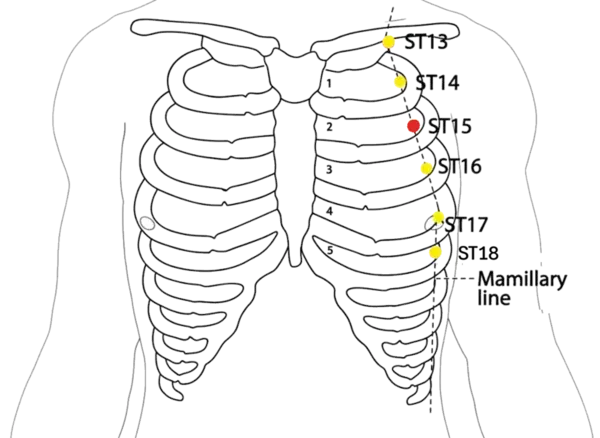ST-15 - Roof
屋翳 - Wū yì
Point Region: Chest
ST-15 Wuyi, meaning 'Room Screen,' is a point that calms cough and benefits the breast region. Located on the chest, it is a key point for addressing a wide range of issues that are caused by stagnant Qi or excess heat in the upper body. Its name, 'Room Screen,' alludes to its ability to bring a sense of order and harmony to the body's entire system.
Think of Wuyi as a point that helps to 'screen out the wind' from your chest. It's invaluable for addressing issues like a cough, a feeling of a 'tight' chest, and a restless spirit. By calming cough and benefiting the breast region, it helps to restore a sense of ease and freedom.
By calming cough and benefiting the breast region, ST-15 helps to restore a sense of balance and inner peace. It's a point that reminds us that our true power comes from a calm and unburdened body.
Location & How to Find
Anatomical Location: On the chest, in the third intercostal space, 4 cun lateral to the anterior midline, level with CV-18.
How to Locate:
- Find your collar bone and feel for the ribs below it
- Count down to find the third space between your ribs
- This is typically about 3 finger-widths below your collar bone
- The point is in this third intercostal space

Primary Functions
Respiratory System
- Treats cough and respiratory congestion
- Relieves chest tightness and breathing difficulty
- Reduces bronchial inflammation
- Improves lung qi circulation
Lactation Support
- Promotes milk production in nursing mothers
- Treats insufficient lactation
- Relieves breast engorgement and discomfort
Digestive System
- Harmonizes stomach qi in chest region
- Treats chest discomfort from digestive issues
Musculoskeletal System
- Relieves chest and breast muscle tension
- Treats intercostal muscle pain
Clinical Applications
Primary Indications
- Cough with reflux
- Foamy sputum
- Coughing blood
- Intercostal pain
- Chest pain
- Rib pain
- Respiratory problems
- Chest tightness
Related Health Concerns
Common Conditions:
Related Acupoints
Select a point to learn about its location, primary functions, clinical applications, and protocols.
ST-15 Protocols
N/A
Important Precautions
- Recent chest surgery
- Severe intercostal neuralgia
- Chest wall injuries